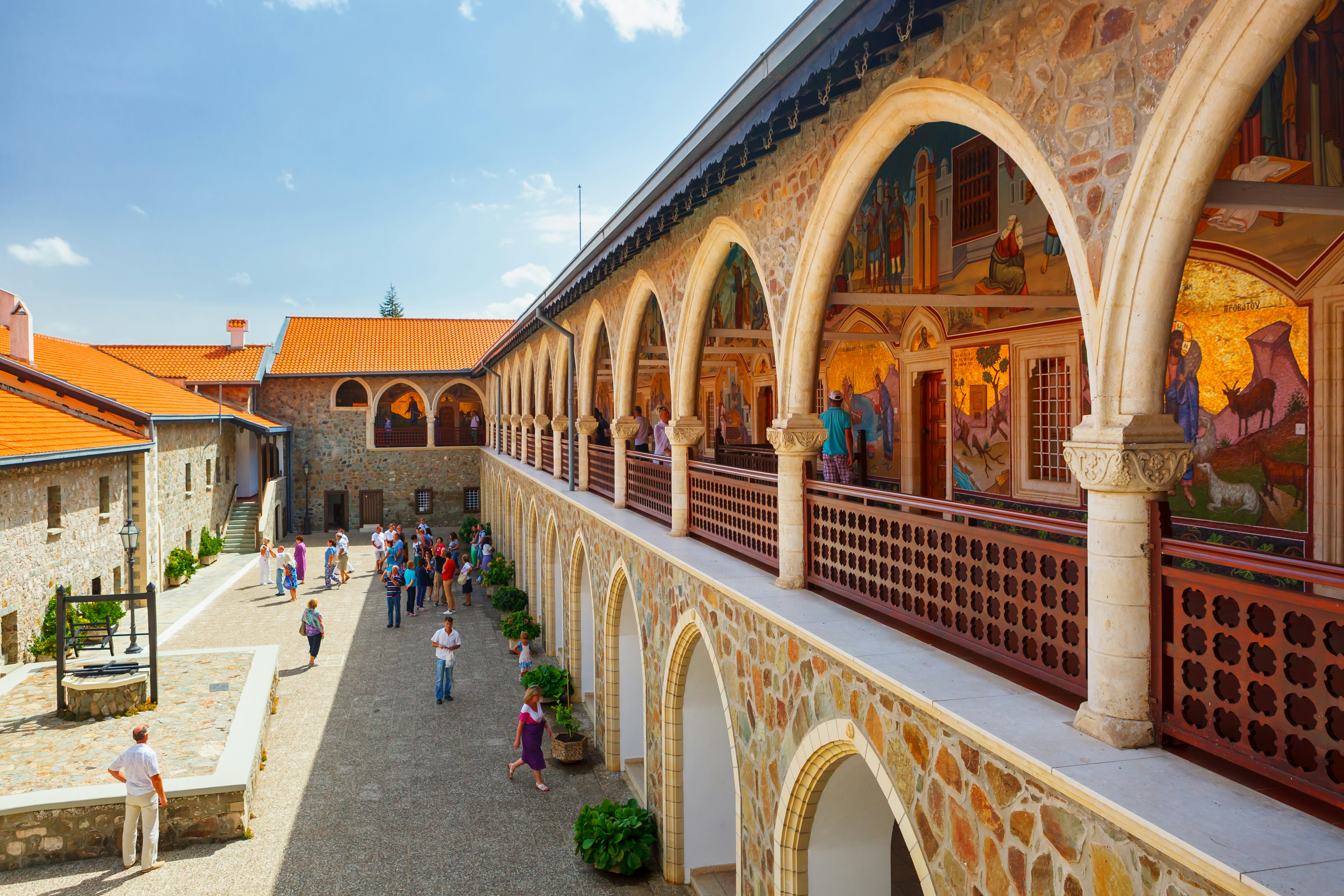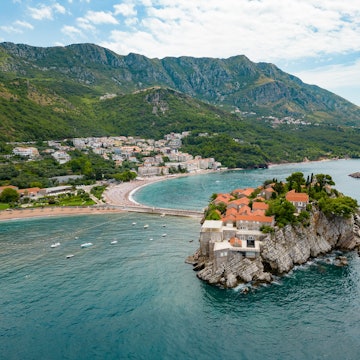
The 12 best places to visit in Cyprus: from Aphrodite's rock to Adonis' bath

Nov 5, 2021 • 6 min read

Moutoullas village in the Nicosia district of Cyprus. Kirillm/Getty Images
In the eastern reaches of the balmy Mediterranean, the island of Cyprus offers an incredible blend of ancient archeological sites, icon-filled monasteries and historic houses of worship, all set against a backdrop of black pine forest and beach-fringed turquoise seas.
Whether you’re a beach basker, a scenery seeker, a fan of Greek mythology or just someone who loves learning about how people lived in ancient times, this island nation won’t disappoint. Here are twelve of the best places to visit in Cyprus.
1. Adonis Baths Waterfalls
Best for swimming
Situated in the village of Kili (Koili) near Pafos, the Adonis Baths provide a lovely alternative to beachfront swimming, offering cool waters that cascade down into a large pool surrounded by forest. According to legend, Aphrodite and her consort, Adonis, spent a considerable amount of time at this bath, and some believe it to be a veritable fountain of youth.
However, most people come here just to cool off on sweltering summer days, and there’s a rope swing for those who want to make a dramatic entry into the waters.
2. Agios Neophytos Monastery
Best for architecture
One of the best-known monasteries on the island, Agios Neophytos is a striking structure, featuring a rocky facade carved into the side of a mountain, over 500 meters above sea level. Today the monastery offers a mix of beautiful architecture and gorgeous icons, and many of the well-preserved frescoes here were created between the 12th and 15th centuries. It's inland from Pafos, on the edge of the Agios Neophytos Forest; on the way, you can detour to curious, cat-filled Tala Monastery.
3. Agios Lazaros (The Church of Saint Lazarus)
Best for a Biblical tour
Dating back to the 9th century, this Orthodox church in Larnaka is known both for its beautifully preserved Byzantine architecture and for housing the tomb of Saint Lazarus, of Bible fame. The limestone exterior is photo-worthy all by itself, but it's worth spending time exploring the interior, not only to view the risen saint's tomb, but also to check out the gilded baroque iconostasis that adorns the church’s shadowy interior.

4. Hala Sultan Tekkesi
Best for finding peace
On the banks of the Larnaka Salt Lake, Hala Sultan Tekkesi is a striking mosque and Sufi shrine that was built over the centuries and finally completed in 1817. It was constructed around the tomb of Umm Haram, an aunt and companion of the Prophet Mohammed. Along with a mosque and shrine, the complex features a series of landscaped courtyards with views out over the saline lake.
Today, it's a quiet monument to Cyprus' pre-partition past. While the architecture and peaceful ambiance are reason enough to visit, many people just come to the complex to say hello to the hundred-odd stray cats who call the Hala Sultan Tekkesi home.
5. Choirokoitia
Best for Neolithic history
The Unesco World Heritage-listed Choirokoitia archaeological site is one of the most significant Neolithic sites in the region, and digs here have helped archaeologists get a better grasp on how people lived in the 7th to 4th millennia BCE.
While only part of the site has been excavated so far, there's still plenty for visitors to see and experience. The most interesting feature is a collection of reconstructions of prehistoric dwellings that have been decked out with replicas of household items that were used in Neolithic times.
6. Pafos Archaeological Site
Best for archaeological discoveries
Spread out by the sea near the center of Pafos, this spectacular complex includes some of the most impressive archaeological sites on the island. It's like an open-air museum, with plenty of best-on-the-island highlights, including an ancient odeon (theater) that is used for performances to this day.
There are also four Roman villas that house a stunning collection of beautifully preserved floor mosaics. The most impressive is the House of Dionysus, whose ornate mosaic floors portray Dionysus, the god of wine, aboard a panther-drawn chariot.
7. The Painted Churches of Troödos
Best for stunning murals
The Unesco World Heritage-listed painted churches of the Troödos mountains have hardly changed since Byzantine times. These crude stone and timber chapels were filled with amazing murals of saints, archangels and Bible scenes between the 11th and 16th centuries, and the colors shine as brightly today as they did when they were painted. If time is short, make a beeline for the churches of Panagia Forviotissa (near Nikitari) and Archangelos Michail (in Pedoulas).

8. Kykkos Monastery
Best for sacred icons
High up in the mountainous interior, west of Pedoulas, Kykkos Monastery is home to a museum showcasing some of the most impressive icons on the island, alongside ancient reliquaries and other votive objects. Kykkos was established in the 11th century after a hermit healed the daughter of the Byzantine emperor at the time, Alexios I Komnenos.
The hermit was rewarded with a sacred icon of the Virgin Mary and the funds to build a monastery to enshrine it. The icon is kept at the monastery to this day, albeit shrouded, as it's believed that anyone who looks upon its beauty will go blind.
9. Kolossi Castle
Best for wine history
West of Lemesos (Limassol), close to the southern coast of Cyprus, stocky Kolossi Castle was used as a stronghold during the Crusades. The castle was occupied by the mysterious Knights Templar during their reign on the island, and it was here that they first produced a type of sweet, fortified wine known as Commandaria, now celebrated as the world's oldest continually produced named wine.
10. Tombs of the Kings
Best for ancient passageways
In the southwest corner of the island, on the outskirts of Paphos, the Tombs of the Kings is an ancient necropolis comprising rock-hewn tombs dating back to the Hellenistic and Roman eras. Here you’ll find a sprawl of sunken graves and underground chambers, some crude and some regal and refined.
Many of the tombs resemble ancient homes, complete with beautifully carved Doric pillars. Although excavation is still in progress, visitors are welcome to explore the tombs on foot, descending rock-hewn steps and passageways into the ancient chambers below.

11. Aphrodite’s Rock (Petra tou Romiou)
Best for a beach day
Situated on the southern coast of Cyprus, between Lemesos and Pafos, this rock formation and beach is believed to be where Aphrodite, the goddess of love and beauty, emerged from the sea. Today, it’s a popular tourist attraction, and while the beach pales in comparison to the sandier spots in nearby Pafos, it's an undeniably scenic spot. According to legend, if you swim around the rock three times, you'll find your true love – just be careful as the sea here can be rough at times.
12. Ancient Kourion
Best for ruins
Between Lemesos and Pafos, the ancient Roman and Hellenistic site of Kourion has one of the most impressive settings in the Mediterranean, perched atop a rocky hillside above an undeveloped shingle beach. The site has everything from the ruins of an early Christian basilica and a Roman theater and bathhouse to ancient villas full of mosaics and crude, rock-cut tombs at the base of the cliffs.













